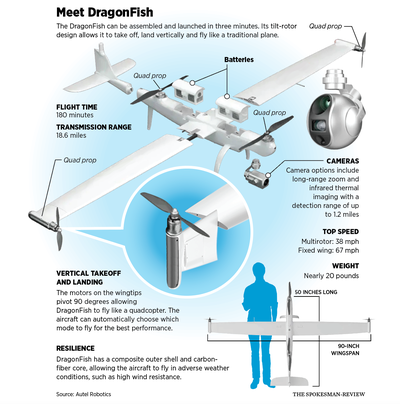An expensive eye in the sky: Spokane police will use new $164,000 drone to fight crime

The Spokane Police Department is purchasing an advanced surveillance drone for just over $164,000 that police officials say will increase officer safety and effectiveness during pursuits.
The Autel Dragonfish is an uncrewed aerial system, or UAS, more commonly referred to as a drone, that was approved for purchase at a July 22 City Council meeting.
It provides longer flight times, increased range and a capability to follow a vehicle or person that the department’s current drones don’t have, said Spokane police Capt. Matthew Cowles.
“They are absolutely critical to provide safety to our officers and the public,” Cowles said.
The drone unit in Spokane started in 2018 and has evolved to help with different functions through the Spokane Police Department’s patrol unit. The drone unit is used daily, he added.
Spokane police use a variety of what are called DJI quadcopters. They have eight interior drones ranging from $2,000 to $5,000 each, and eight exterior drones ranging from $7,000 to $12,000 each, the department’s public safety communications manager Julie Humphreys wrote in an email.
Quadcopters are effectively mini-helicopters with four blades surrounding the main body of the drone. The Dragonfish has vertical takeoff and landing capabilities like the quadcopters, but it’s a fixed-wing aircraft, which allows it to cover a larger area and travel faster.
The new drone has a transmission range – the distance it can be from the operator – of almost 19 miles and a flight time of two hours, both of which Cowles said are upgrades .
The Dragonfish is also more weather -resistant.
The drone comes equipped with a gimbal mount and two camera options, including long-range zoom and infrared thermal imaging with a detection range of up to 2,000 meters, according to the Autel Robotics website.
“If the drone’s airborne, it would be able to take over pursuits or vehicles, greatly limiting, then decreasing, the risk to the public and officers,” Cowles said. “With the drone, the people in the vehicles would likely be unaware that law enforcement is tracking them at all.”
In addition to using the drone for vehicle pursuits, it could also be used for high-risk warrants and calls, Cowles added.
“It really is a great de-escalation tool and a means of making sure that officers, when they’re responding to a call, get accurate, timely information so that they’re safe, and the people who they’re responding to calls to help can be safe too,” he said.
Drones, despite their potential for increased safety, have raised some concerns.
“We are adamantly against the use of drones for routine, suspicionless, or mass surveillance,” wrote Jay Stanley, senior policy analyst at the American Civil Liberties Union, in a paper published in July 2023.
Stanley claimed it is “clear that police departments will push their use of drones beyond emergency response,” citing an example of the Chula Vista (California) Police Department and its “drone first responder” philosophy, which has dispatched drones for reports such as “bouncing a ball against a garage.”
“This is a classic case of government powers being justified by the most serious applications – and then their uses rapidly expanding to much more mundane purposes,” Stanley wrote.
Stanley expressed concern that police drones would become a common sight.
“Without strong privacy protections we end up with the functional equivalent of a mass surveillance regime in the skies,” he wrote. This common sight and regular surveillance would create “feelings of powerlessness and is inherently stressful and stifling,” Stanley added.
Humphreys assured that drones would not be used for routine surveillance.
“The SPD makes decisions on deploying any of our specialty units, including drones, based on the circumstances of the particular incident,” she said. “If the incident calls for a drone, that’s when we would deploy one.”
Cowles said the drone pilots will be tested and trained in accordance with Federal Aviation Administration regulations.
There are eight pilots in the Spokane Police Department’s drone program. Some advanced pilots will be earmarked for the Dragonfish training program, eventually resulting in a small group who will be capable of flying the new drone, Cowles said.
The internal selection process for these pilots was described by Cowles as a competition.
The department has ongoing training for its other drones, and the training for the Dragonfish will fold into the current program, Humphreys said.
“As long as they’re in the unit, their training will never end,” Cowles said.
Spokane’s drone program is similar to others in the U.S.
“It’s a trend nationwide, and drones are involved increasingly in solving more and more crimes,” Humphreys said.
The Dragonfish has been a project of Cowles since 2020, when he said he started bringing it up at meetings. It was purchased this year with grant funds as part of a $1.3 million allotment that Rep. Cathy McMorris Rodgers, who represents Eastern Washington in Congress, secured for Spokane police, Humphreys wrote in an email.
The drone is covered “by and large” by grants, Humphreys said.
“Without that grant, purchasing something along these lines would have been nearly impossible,” Cowles said.
The grant funds also pay for a number of other technology updates, such as a LIMA cellular network scanner, which validates cellular network data from a cell carrier. It will be used to double-check information such as call logs and locations acquired from companies such as Verizon and AT&T through warrants, Humphreys said.
“We’re always looking to keep up with the most current technological advances that assist police in doing their work,” Humphreys said. “It’s part of an overall philosophy to have the most updated equipment. “We have to stay on top of it to have the best possible tools to do our work and to be able to enforce the laws.”